Research Project: International Students and NZ Qualifications
VerifiedAdded on 2023/03/30
|23
|4521
|253
Report
AI Summary
This research report investigates the preferences of international students regarding New Zealand-based qualifications. The study examines the factors influencing their choices, the benefits offered by NZ universities, and the motivations behind choosing NZ for higher education. The report employs a mixed-methods approach, including surveys and interviews with 15 respondents, to gather both qualitative and quantitative data. The research delves into the strategies and amenities provided by NZ universities to attract foreign students, analyzing the perceptions of international students and recommending strategies to address existing challenges. The methodology includes the Research Onion model, positivism philosophy, and a descriptive research design, with primary and secondary data collection methods. The report also addresses ethical considerations, limitations, and delimitations of the study, providing a comprehensive overview of the topic and its implications for the NZ education system.
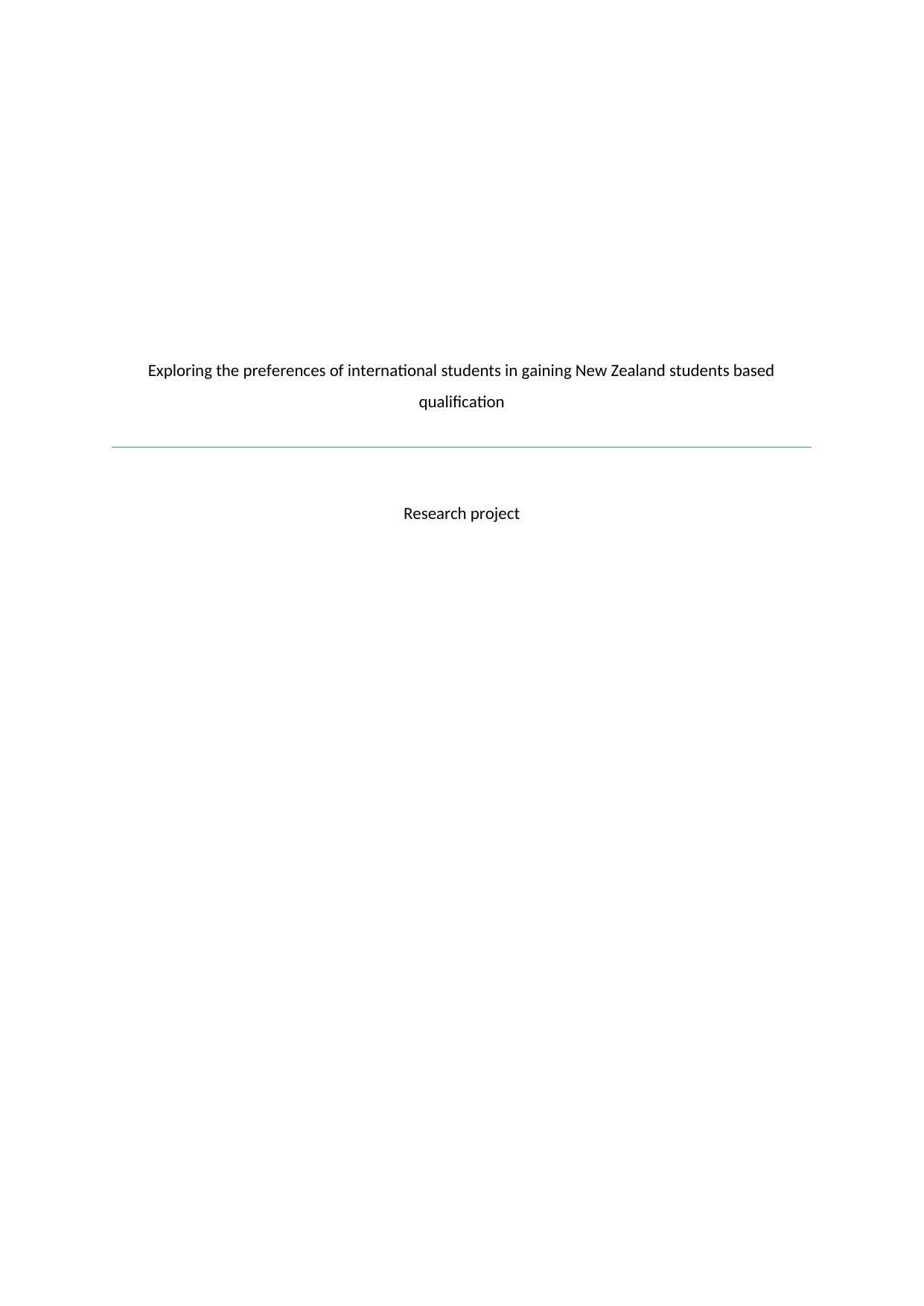
Exploring the preferences of international students in gaining New Zealand students based
qualification
Research project
qualification
Research project
Paraphrase This Document
Need a fresh take? Get an instant paraphrase of this document with our AI Paraphraser
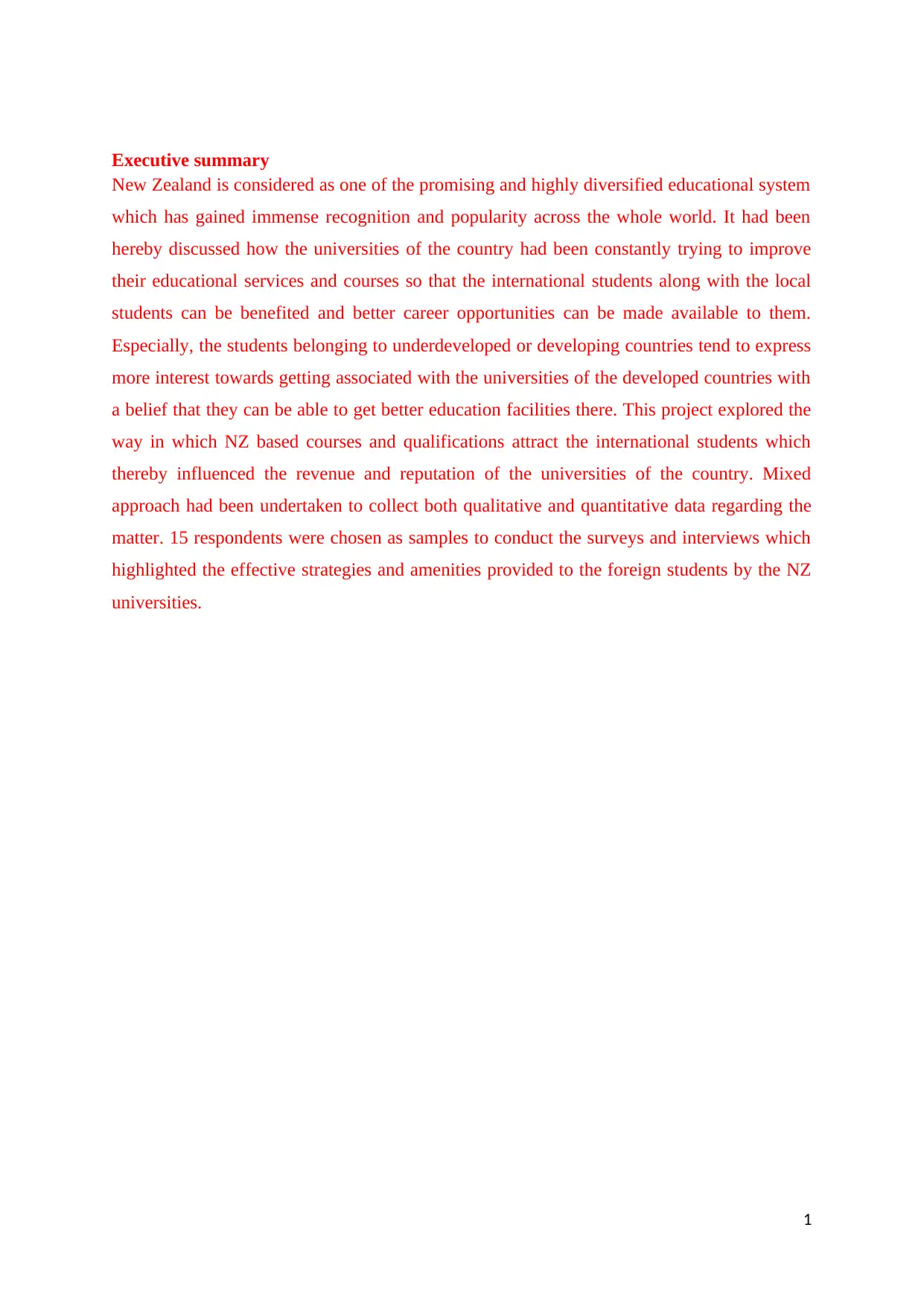
Executive summary
New Zealand is considered as one of the promising and highly diversified educational system
which has gained immense recognition and popularity across the whole world. It had been
hereby discussed how the universities of the country had been constantly trying to improve
their educational services and courses so that the international students along with the local
students can be benefited and better career opportunities can be made available to them.
Especially, the students belonging to underdeveloped or developing countries tend to express
more interest towards getting associated with the universities of the developed countries with
a belief that they can be able to get better education facilities there. This project explored the
way in which NZ based courses and qualifications attract the international students which
thereby influenced the revenue and reputation of the universities of the country. Mixed
approach had been undertaken to collect both qualitative and quantitative data regarding the
matter. 15 respondents were chosen as samples to conduct the surveys and interviews which
highlighted the effective strategies and amenities provided to the foreign students by the NZ
universities.
1
New Zealand is considered as one of the promising and highly diversified educational system
which has gained immense recognition and popularity across the whole world. It had been
hereby discussed how the universities of the country had been constantly trying to improve
their educational services and courses so that the international students along with the local
students can be benefited and better career opportunities can be made available to them.
Especially, the students belonging to underdeveloped or developing countries tend to express
more interest towards getting associated with the universities of the developed countries with
a belief that they can be able to get better education facilities there. This project explored the
way in which NZ based courses and qualifications attract the international students which
thereby influenced the revenue and reputation of the universities of the country. Mixed
approach had been undertaken to collect both qualitative and quantitative data regarding the
matter. 15 respondents were chosen as samples to conduct the surveys and interviews which
highlighted the effective strategies and amenities provided to the foreign students by the NZ
universities.
1
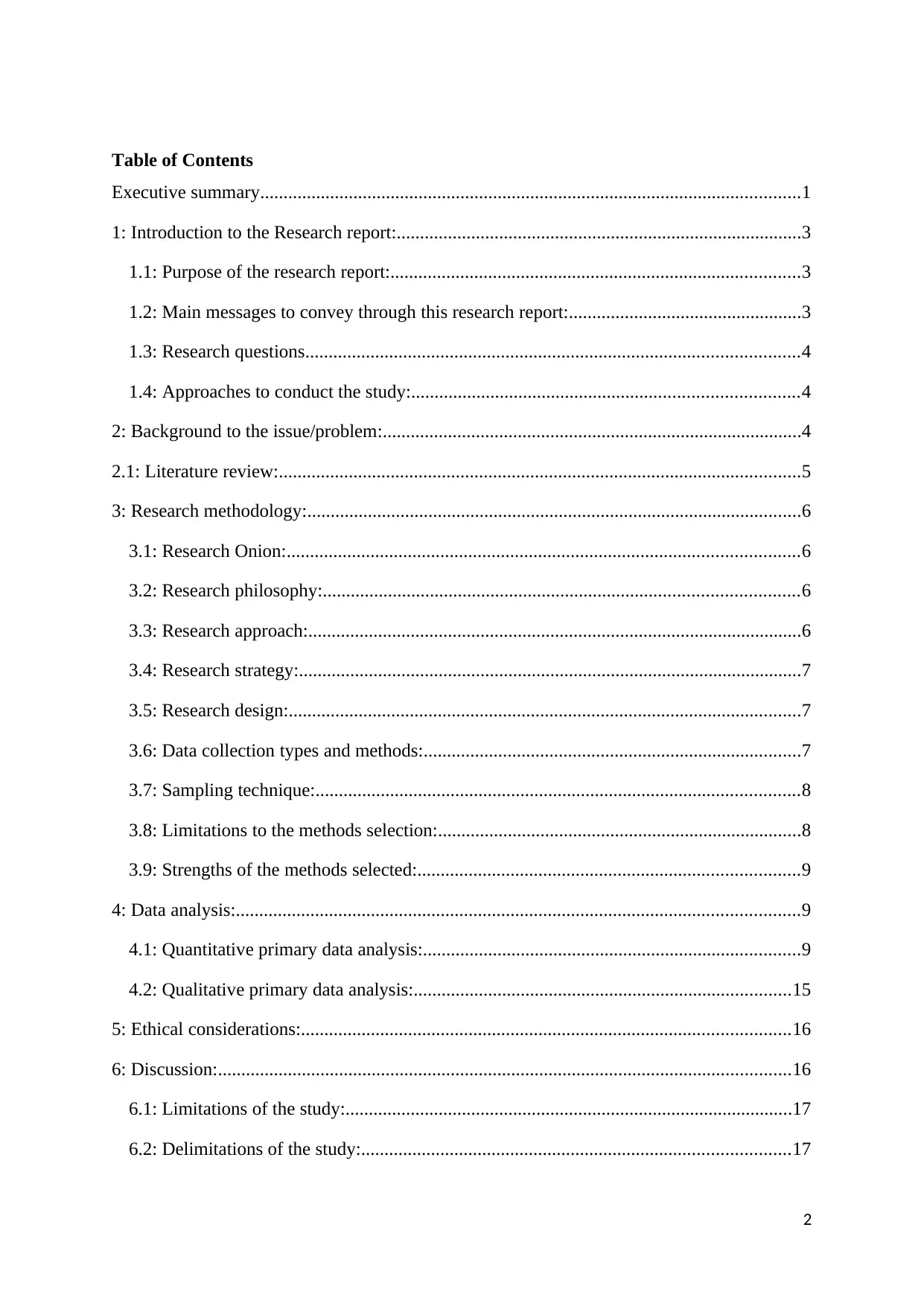
Table of Contents
Executive summary....................................................................................................................1
1: Introduction to the Research report:.......................................................................................3
1.1: Purpose of the research report:........................................................................................3
1.2: Main messages to convey through this research report:..................................................3
1.3: Research questions..........................................................................................................4
1.4: Approaches to conduct the study:...................................................................................4
2: Background to the issue/problem:..........................................................................................4
2.1: Literature review:................................................................................................................5
3: Research methodology:..........................................................................................................6
3.1: Research Onion:..............................................................................................................6
3.2: Research philosophy:......................................................................................................6
3.3: Research approach:..........................................................................................................6
3.4: Research strategy:............................................................................................................7
3.5: Research design:..............................................................................................................7
3.6: Data collection types and methods:.................................................................................7
3.7: Sampling technique:........................................................................................................8
3.8: Limitations to the methods selection:..............................................................................8
3.9: Strengths of the methods selected:..................................................................................9
4: Data analysis:.........................................................................................................................9
4.1: Quantitative primary data analysis:.................................................................................9
4.2: Qualitative primary data analysis:.................................................................................15
5: Ethical considerations:.........................................................................................................16
6: Discussion:...........................................................................................................................16
6.1: Limitations of the study:................................................................................................17
6.2: Delimitations of the study:............................................................................................17
2
Executive summary....................................................................................................................1
1: Introduction to the Research report:.......................................................................................3
1.1: Purpose of the research report:........................................................................................3
1.2: Main messages to convey through this research report:..................................................3
1.3: Research questions..........................................................................................................4
1.4: Approaches to conduct the study:...................................................................................4
2: Background to the issue/problem:..........................................................................................4
2.1: Literature review:................................................................................................................5
3: Research methodology:..........................................................................................................6
3.1: Research Onion:..............................................................................................................6
3.2: Research philosophy:......................................................................................................6
3.3: Research approach:..........................................................................................................6
3.4: Research strategy:............................................................................................................7
3.5: Research design:..............................................................................................................7
3.6: Data collection types and methods:.................................................................................7
3.7: Sampling technique:........................................................................................................8
3.8: Limitations to the methods selection:..............................................................................8
3.9: Strengths of the methods selected:..................................................................................9
4: Data analysis:.........................................................................................................................9
4.1: Quantitative primary data analysis:.................................................................................9
4.2: Qualitative primary data analysis:.................................................................................15
5: Ethical considerations:.........................................................................................................16
6: Discussion:...........................................................................................................................16
6.1: Limitations of the study:................................................................................................17
6.2: Delimitations of the study:............................................................................................17
2
⊘ This is a preview!⊘
Do you want full access?
Subscribe today to unlock all pages.

Trusted by 1+ million students worldwide

References:...............................................................................................................................18
Appendix: (Quantitative questionnaire)...................................................................................19
3
Appendix: (Quantitative questionnaire)...................................................................................19
3
Paraphrase This Document
Need a fresh take? Get an instant paraphrase of this document with our AI Paraphraser
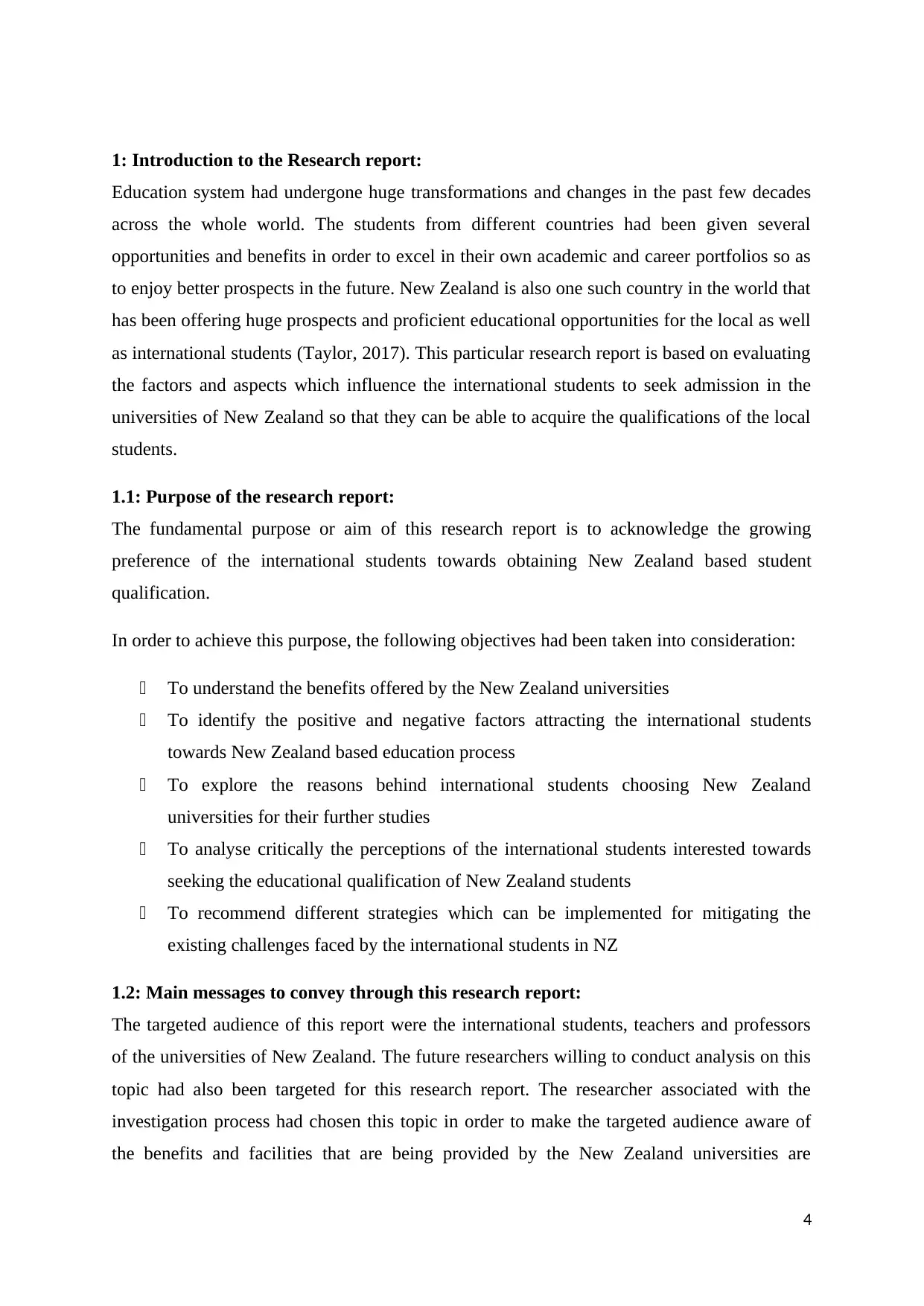
1: Introduction to the Research report:
Education system had undergone huge transformations and changes in the past few decades
across the whole world. The students from different countries had been given several
opportunities and benefits in order to excel in their own academic and career portfolios so as
to enjoy better prospects in the future. New Zealand is also one such country in the world that
has been offering huge prospects and proficient educational opportunities for the local as well
as international students (Taylor, 2017). This particular research report is based on evaluating
the factors and aspects which influence the international students to seek admission in the
universities of New Zealand so that they can be able to acquire the qualifications of the local
students.
1.1: Purpose of the research report:
The fundamental purpose or aim of this research report is to acknowledge the growing
preference of the international students towards obtaining New Zealand based student
qualification.
In order to achieve this purpose, the following objectives had been taken into consideration:
To understand the benefits offered by the New Zealand universities
To identify the positive and negative factors attracting the international students
towards New Zealand based education process
To explore the reasons behind international students choosing New Zealand
universities for their further studies
To analyse critically the perceptions of the international students interested towards
seeking the educational qualification of New Zealand students
To recommend different strategies which can be implemented for mitigating the
existing challenges faced by the international students in NZ
1.2: Main messages to convey through this research report:
The targeted audience of this report were the international students, teachers and professors
of the universities of New Zealand. The future researchers willing to conduct analysis on this
topic had also been targeted for this research report. The researcher associated with the
investigation process had chosen this topic in order to make the targeted audience aware of
the benefits and facilities that are being provided by the New Zealand universities are
4
Education system had undergone huge transformations and changes in the past few decades
across the whole world. The students from different countries had been given several
opportunities and benefits in order to excel in their own academic and career portfolios so as
to enjoy better prospects in the future. New Zealand is also one such country in the world that
has been offering huge prospects and proficient educational opportunities for the local as well
as international students (Taylor, 2017). This particular research report is based on evaluating
the factors and aspects which influence the international students to seek admission in the
universities of New Zealand so that they can be able to acquire the qualifications of the local
students.
1.1: Purpose of the research report:
The fundamental purpose or aim of this research report is to acknowledge the growing
preference of the international students towards obtaining New Zealand based student
qualification.
In order to achieve this purpose, the following objectives had been taken into consideration:
To understand the benefits offered by the New Zealand universities
To identify the positive and negative factors attracting the international students
towards New Zealand based education process
To explore the reasons behind international students choosing New Zealand
universities for their further studies
To analyse critically the perceptions of the international students interested towards
seeking the educational qualification of New Zealand students
To recommend different strategies which can be implemented for mitigating the
existing challenges faced by the international students in NZ
1.2: Main messages to convey through this research report:
The targeted audience of this report were the international students, teachers and professors
of the universities of New Zealand. The future researchers willing to conduct analysis on this
topic had also been targeted for this research report. The researcher associated with the
investigation process had chosen this topic in order to make the targeted audience aware of
the benefits and facilities that are being provided by the New Zealand universities are
4
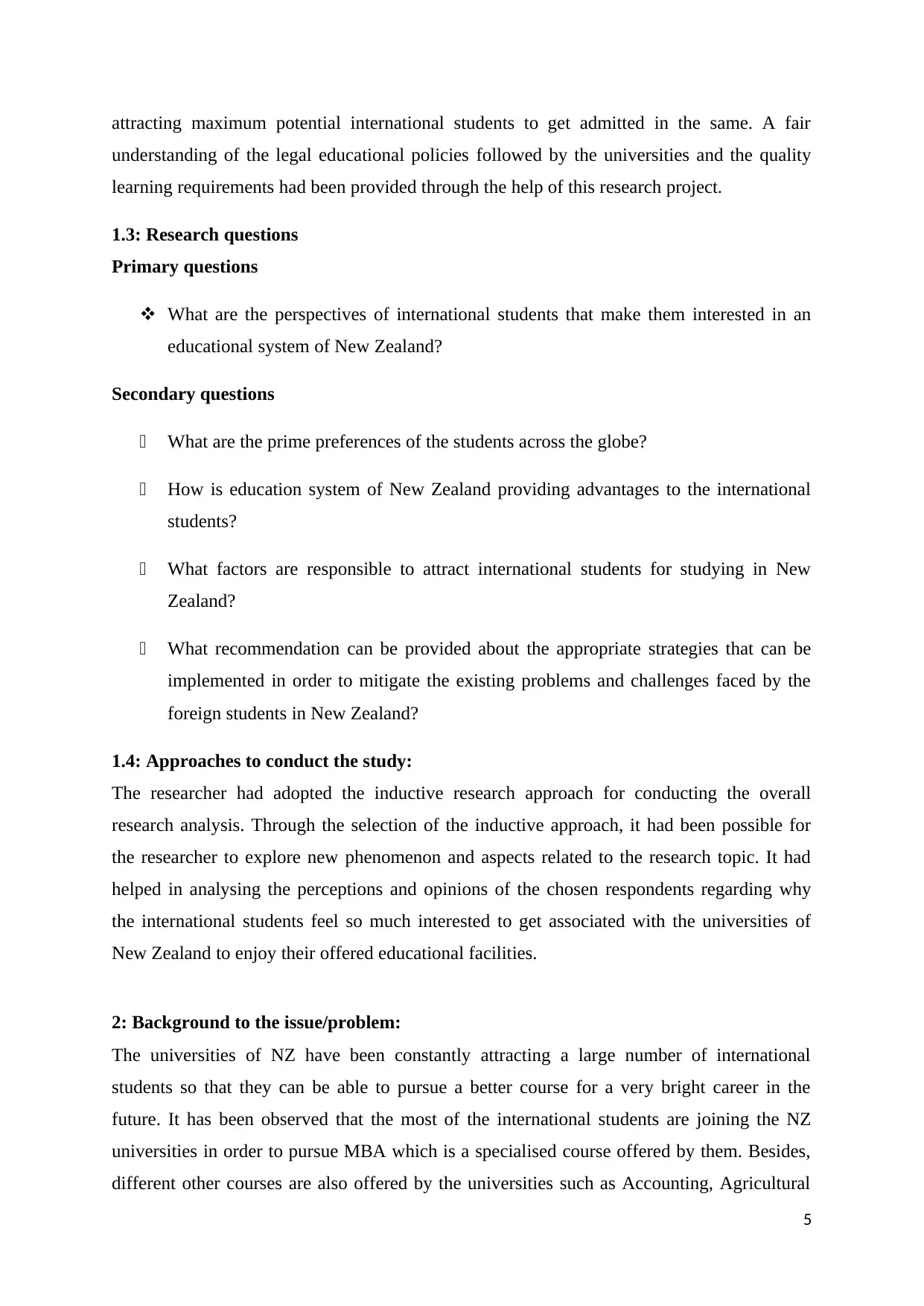
attracting maximum potential international students to get admitted in the same. A fair
understanding of the legal educational policies followed by the universities and the quality
learning requirements had been provided through the help of this research project.
1.3: Research questions
Primary questions
What are the perspectives of international students that make them interested in an
educational system of New Zealand?
Secondary questions
What are the prime preferences of the students across the globe?
How is education system of New Zealand providing advantages to the international
students?
What factors are responsible to attract international students for studying in New
Zealand?
What recommendation can be provided about the appropriate strategies that can be
implemented in order to mitigate the existing problems and challenges faced by the
foreign students in New Zealand?
1.4: Approaches to conduct the study:
The researcher had adopted the inductive research approach for conducting the overall
research analysis. Through the selection of the inductive approach, it had been possible for
the researcher to explore new phenomenon and aspects related to the research topic. It had
helped in analysing the perceptions and opinions of the chosen respondents regarding why
the international students feel so much interested to get associated with the universities of
New Zealand to enjoy their offered educational facilities.
2: Background to the issue/problem:
The universities of NZ have been constantly attracting a large number of international
students so that they can be able to pursue a better course for a very bright career in the
future. It has been observed that the most of the international students are joining the NZ
universities in order to pursue MBA which is a specialised course offered by them. Besides,
different other courses are also offered by the universities such as Accounting, Agricultural
5
understanding of the legal educational policies followed by the universities and the quality
learning requirements had been provided through the help of this research project.
1.3: Research questions
Primary questions
What are the perspectives of international students that make them interested in an
educational system of New Zealand?
Secondary questions
What are the prime preferences of the students across the globe?
How is education system of New Zealand providing advantages to the international
students?
What factors are responsible to attract international students for studying in New
Zealand?
What recommendation can be provided about the appropriate strategies that can be
implemented in order to mitigate the existing problems and challenges faced by the
foreign students in New Zealand?
1.4: Approaches to conduct the study:
The researcher had adopted the inductive research approach for conducting the overall
research analysis. Through the selection of the inductive approach, it had been possible for
the researcher to explore new phenomenon and aspects related to the research topic. It had
helped in analysing the perceptions and opinions of the chosen respondents regarding why
the international students feel so much interested to get associated with the universities of
New Zealand to enjoy their offered educational facilities.
2: Background to the issue/problem:
The universities of NZ have been constantly attracting a large number of international
students so that they can be able to pursue a better course for a very bright career in the
future. It has been observed that the most of the international students are joining the NZ
universities in order to pursue MBA which is a specialised course offered by them. Besides,
different other courses are also offered by the universities such as Accounting, Agricultural
5
⊘ This is a preview!⊘
Do you want full access?
Subscribe today to unlock all pages.

Trusted by 1+ million students worldwide
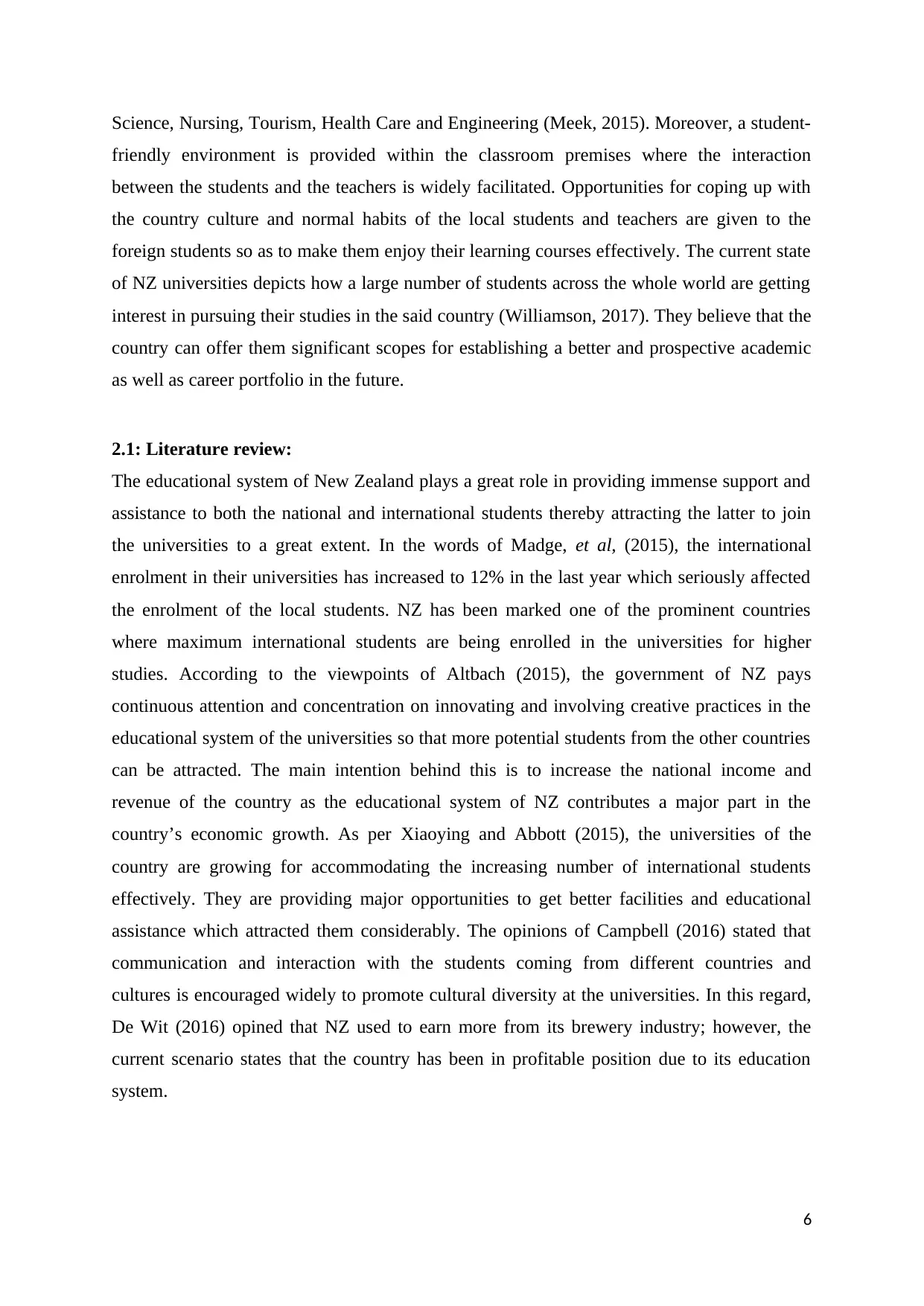
Science, Nursing, Tourism, Health Care and Engineering (Meek, 2015). Moreover, a student-
friendly environment is provided within the classroom premises where the interaction
between the students and the teachers is widely facilitated. Opportunities for coping up with
the country culture and normal habits of the local students and teachers are given to the
foreign students so as to make them enjoy their learning courses effectively. The current state
of NZ universities depicts how a large number of students across the whole world are getting
interest in pursuing their studies in the said country (Williamson, 2017). They believe that the
country can offer them significant scopes for establishing a better and prospective academic
as well as career portfolio in the future.
2.1: Literature review:
The educational system of New Zealand plays a great role in providing immense support and
assistance to both the national and international students thereby attracting the latter to join
the universities to a great extent. In the words of Madge, et al, (2015), the international
enrolment in their universities has increased to 12% in the last year which seriously affected
the enrolment of the local students. NZ has been marked one of the prominent countries
where maximum international students are being enrolled in the universities for higher
studies. According to the viewpoints of Altbach (2015), the government of NZ pays
continuous attention and concentration on innovating and involving creative practices in the
educational system of the universities so that more potential students from the other countries
can be attracted. The main intention behind this is to increase the national income and
revenue of the country as the educational system of NZ contributes a major part in the
country’s economic growth. As per Xiaoying and Abbott (2015), the universities of the
country are growing for accommodating the increasing number of international students
effectively. They are providing major opportunities to get better facilities and educational
assistance which attracted them considerably. The opinions of Campbell (2016) stated that
communication and interaction with the students coming from different countries and
cultures is encouraged widely to promote cultural diversity at the universities. In this regard,
De Wit (2016) opined that NZ used to earn more from its brewery industry; however, the
current scenario states that the country has been in profitable position due to its education
system.
6
friendly environment is provided within the classroom premises where the interaction
between the students and the teachers is widely facilitated. Opportunities for coping up with
the country culture and normal habits of the local students and teachers are given to the
foreign students so as to make them enjoy their learning courses effectively. The current state
of NZ universities depicts how a large number of students across the whole world are getting
interest in pursuing their studies in the said country (Williamson, 2017). They believe that the
country can offer them significant scopes for establishing a better and prospective academic
as well as career portfolio in the future.
2.1: Literature review:
The educational system of New Zealand plays a great role in providing immense support and
assistance to both the national and international students thereby attracting the latter to join
the universities to a great extent. In the words of Madge, et al, (2015), the international
enrolment in their universities has increased to 12% in the last year which seriously affected
the enrolment of the local students. NZ has been marked one of the prominent countries
where maximum international students are being enrolled in the universities for higher
studies. According to the viewpoints of Altbach (2015), the government of NZ pays
continuous attention and concentration on innovating and involving creative practices in the
educational system of the universities so that more potential students from the other countries
can be attracted. The main intention behind this is to increase the national income and
revenue of the country as the educational system of NZ contributes a major part in the
country’s economic growth. As per Xiaoying and Abbott (2015), the universities of the
country are growing for accommodating the increasing number of international students
effectively. They are providing major opportunities to get better facilities and educational
assistance which attracted them considerably. The opinions of Campbell (2016) stated that
communication and interaction with the students coming from different countries and
cultures is encouraged widely to promote cultural diversity at the universities. In this regard,
De Wit (2016) opined that NZ used to earn more from its brewery industry; however, the
current scenario states that the country has been in profitable position due to its education
system.
6
Paraphrase This Document
Need a fresh take? Get an instant paraphrase of this document with our AI Paraphraser
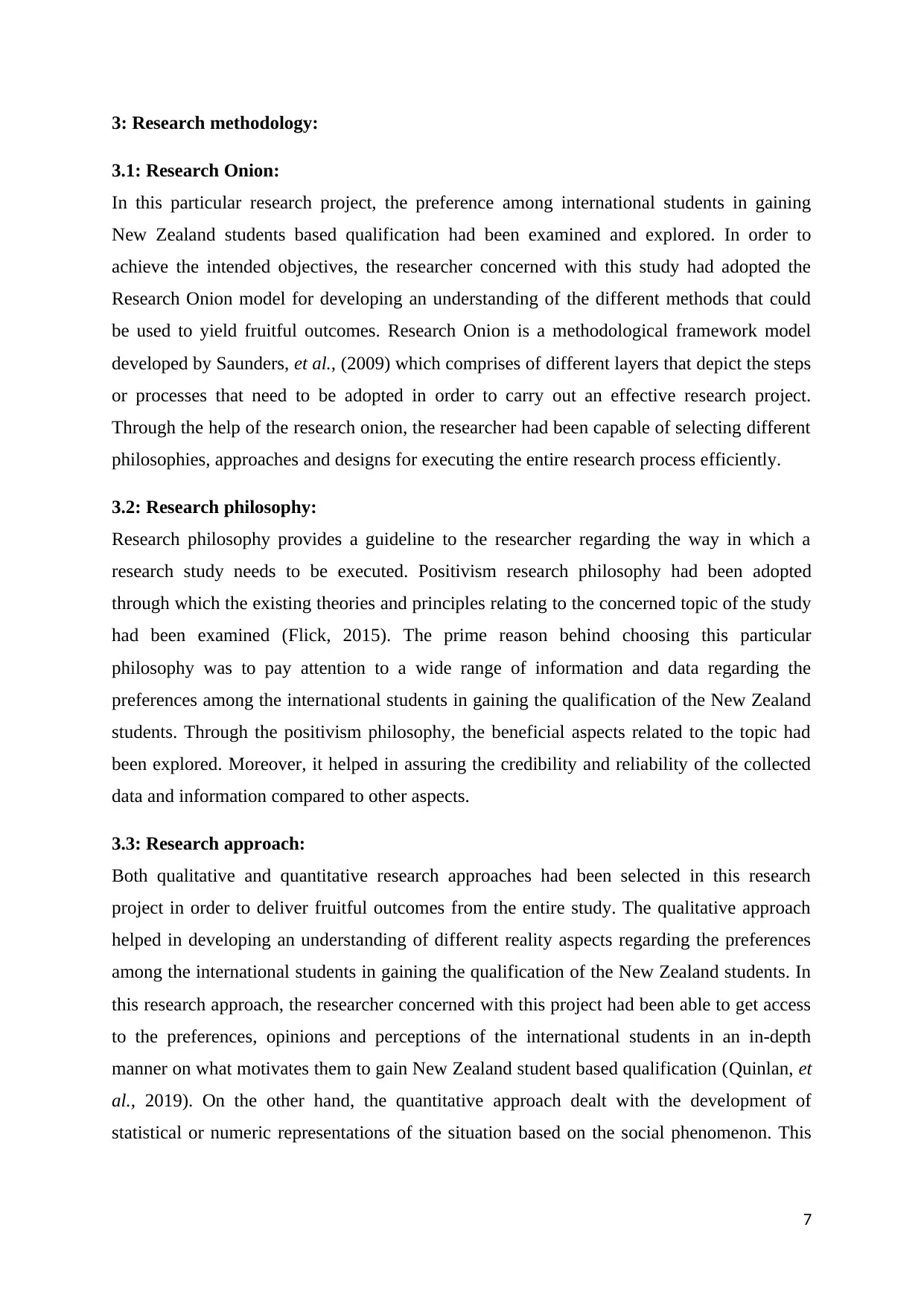
3: Research methodology:
3.1: Research Onion:
In this particular research project, the preference among international students in gaining
New Zealand students based qualification had been examined and explored. In order to
achieve the intended objectives, the researcher concerned with this study had adopted the
Research Onion model for developing an understanding of the different methods that could
be used to yield fruitful outcomes. Research Onion is a methodological framework model
developed by Saunders, et al., (2009) which comprises of different layers that depict the steps
or processes that need to be adopted in order to carry out an effective research project.
Through the help of the research onion, the researcher had been capable of selecting different
philosophies, approaches and designs for executing the entire research process efficiently.
3.2: Research philosophy:
Research philosophy provides a guideline to the researcher regarding the way in which a
research study needs to be executed. Positivism research philosophy had been adopted
through which the existing theories and principles relating to the concerned topic of the study
had been examined (Flick, 2015). The prime reason behind choosing this particular
philosophy was to pay attention to a wide range of information and data regarding the
preferences among the international students in gaining the qualification of the New Zealand
students. Through the positivism philosophy, the beneficial aspects related to the topic had
been explored. Moreover, it helped in assuring the credibility and reliability of the collected
data and information compared to other aspects.
3.3: Research approach:
Both qualitative and quantitative research approaches had been selected in this research
project in order to deliver fruitful outcomes from the entire study. The qualitative approach
helped in developing an understanding of different reality aspects regarding the preferences
among the international students in gaining the qualification of the New Zealand students. In
this research approach, the researcher concerned with this project had been able to get access
to the preferences, opinions and perceptions of the international students in an in-depth
manner on what motivates them to gain New Zealand student based qualification (Quinlan, et
al., 2019). On the other hand, the quantitative approach dealt with the development of
statistical or numeric representations of the situation based on the social phenomenon. This
7
3.1: Research Onion:
In this particular research project, the preference among international students in gaining
New Zealand students based qualification had been examined and explored. In order to
achieve the intended objectives, the researcher concerned with this study had adopted the
Research Onion model for developing an understanding of the different methods that could
be used to yield fruitful outcomes. Research Onion is a methodological framework model
developed by Saunders, et al., (2009) which comprises of different layers that depict the steps
or processes that need to be adopted in order to carry out an effective research project.
Through the help of the research onion, the researcher had been capable of selecting different
philosophies, approaches and designs for executing the entire research process efficiently.
3.2: Research philosophy:
Research philosophy provides a guideline to the researcher regarding the way in which a
research study needs to be executed. Positivism research philosophy had been adopted
through which the existing theories and principles relating to the concerned topic of the study
had been examined (Flick, 2015). The prime reason behind choosing this particular
philosophy was to pay attention to a wide range of information and data regarding the
preferences among the international students in gaining the qualification of the New Zealand
students. Through the positivism philosophy, the beneficial aspects related to the topic had
been explored. Moreover, it helped in assuring the credibility and reliability of the collected
data and information compared to other aspects.
3.3: Research approach:
Both qualitative and quantitative research approaches had been selected in this research
project in order to deliver fruitful outcomes from the entire study. The qualitative approach
helped in developing an understanding of different reality aspects regarding the preferences
among the international students in gaining the qualification of the New Zealand students. In
this research approach, the researcher concerned with this project had been able to get access
to the preferences, opinions and perceptions of the international students in an in-depth
manner on what motivates them to gain New Zealand student based qualification (Quinlan, et
al., 2019). On the other hand, the quantitative approach dealt with the development of
statistical or numeric representations of the situation based on the social phenomenon. This
7
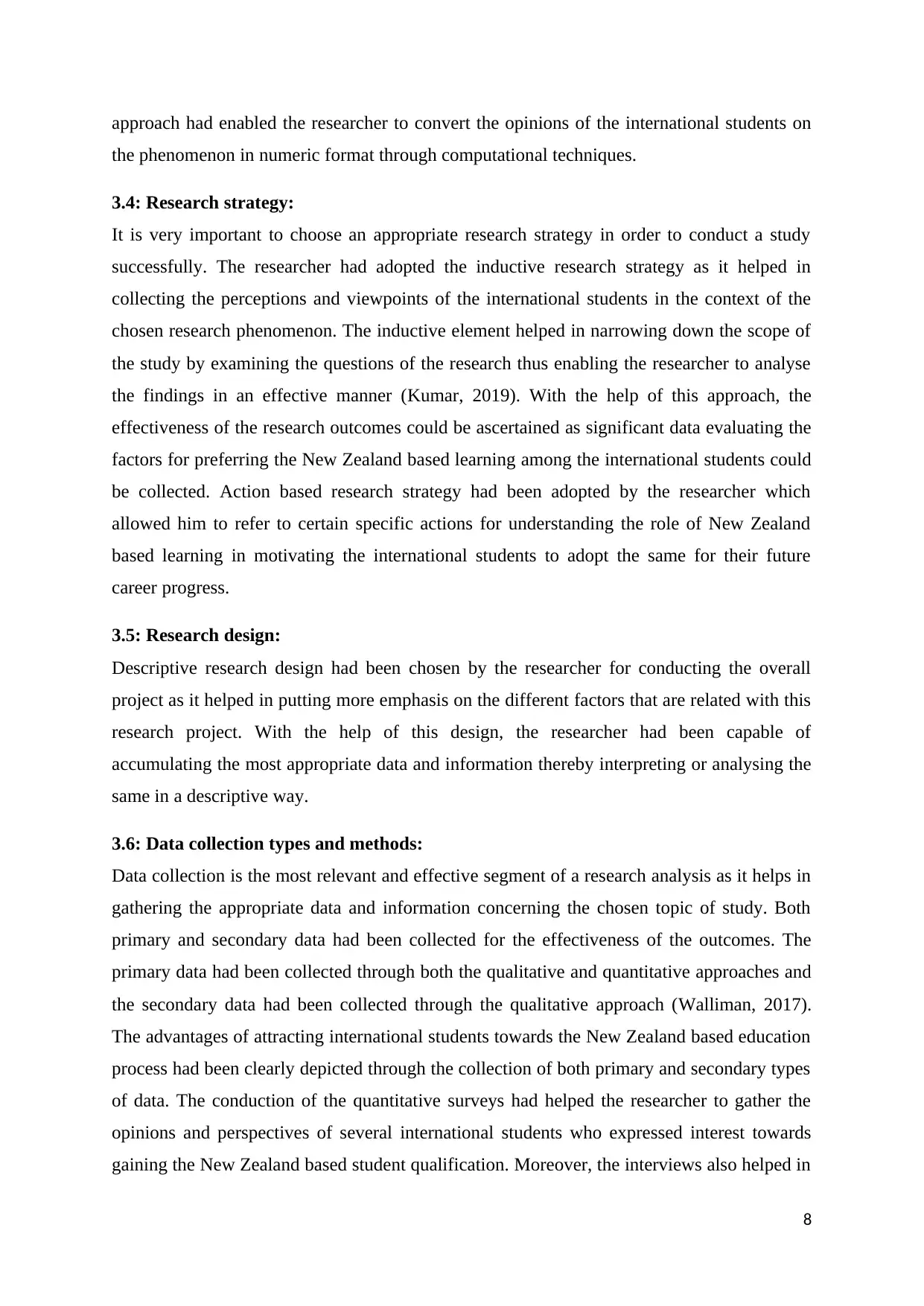
approach had enabled the researcher to convert the opinions of the international students on
the phenomenon in numeric format through computational techniques.
3.4: Research strategy:
It is very important to choose an appropriate research strategy in order to conduct a study
successfully. The researcher had adopted the inductive research strategy as it helped in
collecting the perceptions and viewpoints of the international students in the context of the
chosen research phenomenon. The inductive element helped in narrowing down the scope of
the study by examining the questions of the research thus enabling the researcher to analyse
the findings in an effective manner (Kumar, 2019). With the help of this approach, the
effectiveness of the research outcomes could be ascertained as significant data evaluating the
factors for preferring the New Zealand based learning among the international students could
be collected. Action based research strategy had been adopted by the researcher which
allowed him to refer to certain specific actions for understanding the role of New Zealand
based learning in motivating the international students to adopt the same for their future
career progress.
3.5: Research design:
Descriptive research design had been chosen by the researcher for conducting the overall
project as it helped in putting more emphasis on the different factors that are related with this
research project. With the help of this design, the researcher had been capable of
accumulating the most appropriate data and information thereby interpreting or analysing the
same in a descriptive way.
3.6: Data collection types and methods:
Data collection is the most relevant and effective segment of a research analysis as it helps in
gathering the appropriate data and information concerning the chosen topic of study. Both
primary and secondary data had been collected for the effectiveness of the outcomes. The
primary data had been collected through both the qualitative and quantitative approaches and
the secondary data had been collected through the qualitative approach (Walliman, 2017).
The advantages of attracting international students towards the New Zealand based education
process had been clearly depicted through the collection of both primary and secondary types
of data. The conduction of the quantitative surveys had helped the researcher to gather the
opinions and perspectives of several international students who expressed interest towards
gaining the New Zealand based student qualification. Moreover, the interviews also helped in
8
the phenomenon in numeric format through computational techniques.
3.4: Research strategy:
It is very important to choose an appropriate research strategy in order to conduct a study
successfully. The researcher had adopted the inductive research strategy as it helped in
collecting the perceptions and viewpoints of the international students in the context of the
chosen research phenomenon. The inductive element helped in narrowing down the scope of
the study by examining the questions of the research thus enabling the researcher to analyse
the findings in an effective manner (Kumar, 2019). With the help of this approach, the
effectiveness of the research outcomes could be ascertained as significant data evaluating the
factors for preferring the New Zealand based learning among the international students could
be collected. Action based research strategy had been adopted by the researcher which
allowed him to refer to certain specific actions for understanding the role of New Zealand
based learning in motivating the international students to adopt the same for their future
career progress.
3.5: Research design:
Descriptive research design had been chosen by the researcher for conducting the overall
project as it helped in putting more emphasis on the different factors that are related with this
research project. With the help of this design, the researcher had been capable of
accumulating the most appropriate data and information thereby interpreting or analysing the
same in a descriptive way.
3.6: Data collection types and methods:
Data collection is the most relevant and effective segment of a research analysis as it helps in
gathering the appropriate data and information concerning the chosen topic of study. Both
primary and secondary data had been collected for the effectiveness of the outcomes. The
primary data had been collected through both the qualitative and quantitative approaches and
the secondary data had been collected through the qualitative approach (Walliman, 2017).
The advantages of attracting international students towards the New Zealand based education
process had been clearly depicted through the collection of both primary and secondary types
of data. The conduction of the quantitative surveys had helped the researcher to gather the
opinions and perspectives of several international students who expressed interest towards
gaining the New Zealand based student qualification. Moreover, the interviews also helped in
8
⊘ This is a preview!⊘
Do you want full access?
Subscribe today to unlock all pages.

Trusted by 1+ million students worldwide
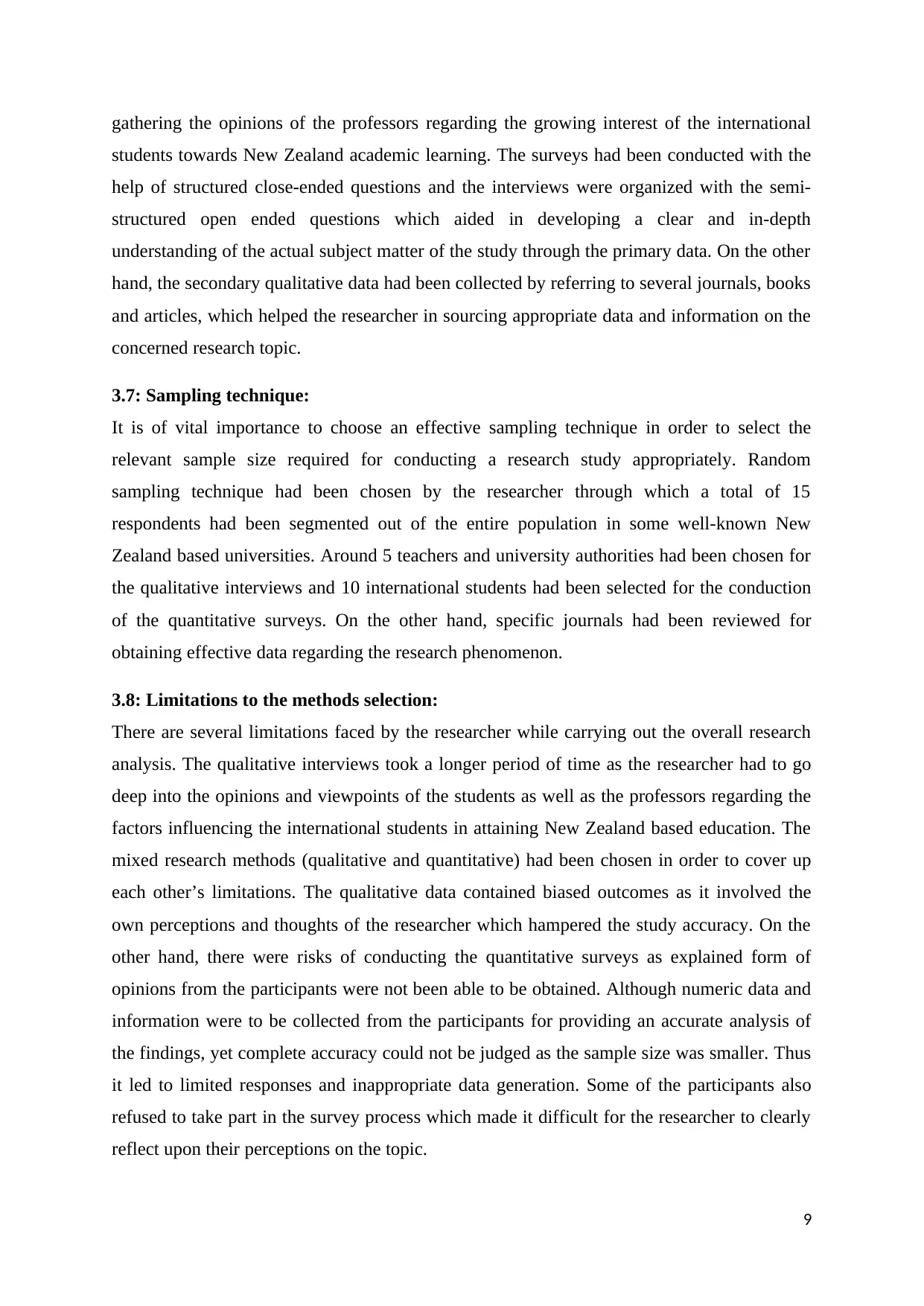
gathering the opinions of the professors regarding the growing interest of the international
students towards New Zealand academic learning. The surveys had been conducted with the
help of structured close-ended questions and the interviews were organized with the semi-
structured open ended questions which aided in developing a clear and in-depth
understanding of the actual subject matter of the study through the primary data. On the other
hand, the secondary qualitative data had been collected by referring to several journals, books
and articles, which helped the researcher in sourcing appropriate data and information on the
concerned research topic.
3.7: Sampling technique:
It is of vital importance to choose an effective sampling technique in order to select the
relevant sample size required for conducting a research study appropriately. Random
sampling technique had been chosen by the researcher through which a total of 15
respondents had been segmented out of the entire population in some well-known New
Zealand based universities. Around 5 teachers and university authorities had been chosen for
the qualitative interviews and 10 international students had been selected for the conduction
of the quantitative surveys. On the other hand, specific journals had been reviewed for
obtaining effective data regarding the research phenomenon.
3.8: Limitations to the methods selection:
There are several limitations faced by the researcher while carrying out the overall research
analysis. The qualitative interviews took a longer period of time as the researcher had to go
deep into the opinions and viewpoints of the students as well as the professors regarding the
factors influencing the international students in attaining New Zealand based education. The
mixed research methods (qualitative and quantitative) had been chosen in order to cover up
each other’s limitations. The qualitative data contained biased outcomes as it involved the
own perceptions and thoughts of the researcher which hampered the study accuracy. On the
other hand, there were risks of conducting the quantitative surveys as explained form of
opinions from the participants were not been able to be obtained. Although numeric data and
information were to be collected from the participants for providing an accurate analysis of
the findings, yet complete accuracy could not be judged as the sample size was smaller. Thus
it led to limited responses and inappropriate data generation. Some of the participants also
refused to take part in the survey process which made it difficult for the researcher to clearly
reflect upon their perceptions on the topic.
9
students towards New Zealand academic learning. The surveys had been conducted with the
help of structured close-ended questions and the interviews were organized with the semi-
structured open ended questions which aided in developing a clear and in-depth
understanding of the actual subject matter of the study through the primary data. On the other
hand, the secondary qualitative data had been collected by referring to several journals, books
and articles, which helped the researcher in sourcing appropriate data and information on the
concerned research topic.
3.7: Sampling technique:
It is of vital importance to choose an effective sampling technique in order to select the
relevant sample size required for conducting a research study appropriately. Random
sampling technique had been chosen by the researcher through which a total of 15
respondents had been segmented out of the entire population in some well-known New
Zealand based universities. Around 5 teachers and university authorities had been chosen for
the qualitative interviews and 10 international students had been selected for the conduction
of the quantitative surveys. On the other hand, specific journals had been reviewed for
obtaining effective data regarding the research phenomenon.
3.8: Limitations to the methods selection:
There are several limitations faced by the researcher while carrying out the overall research
analysis. The qualitative interviews took a longer period of time as the researcher had to go
deep into the opinions and viewpoints of the students as well as the professors regarding the
factors influencing the international students in attaining New Zealand based education. The
mixed research methods (qualitative and quantitative) had been chosen in order to cover up
each other’s limitations. The qualitative data contained biased outcomes as it involved the
own perceptions and thoughts of the researcher which hampered the study accuracy. On the
other hand, there were risks of conducting the quantitative surveys as explained form of
opinions from the participants were not been able to be obtained. Although numeric data and
information were to be collected from the participants for providing an accurate analysis of
the findings, yet complete accuracy could not be judged as the sample size was smaller. Thus
it led to limited responses and inappropriate data generation. Some of the participants also
refused to take part in the survey process which made it difficult for the researcher to clearly
reflect upon their perceptions on the topic.
9
Paraphrase This Document
Need a fresh take? Get an instant paraphrase of this document with our AI Paraphraser
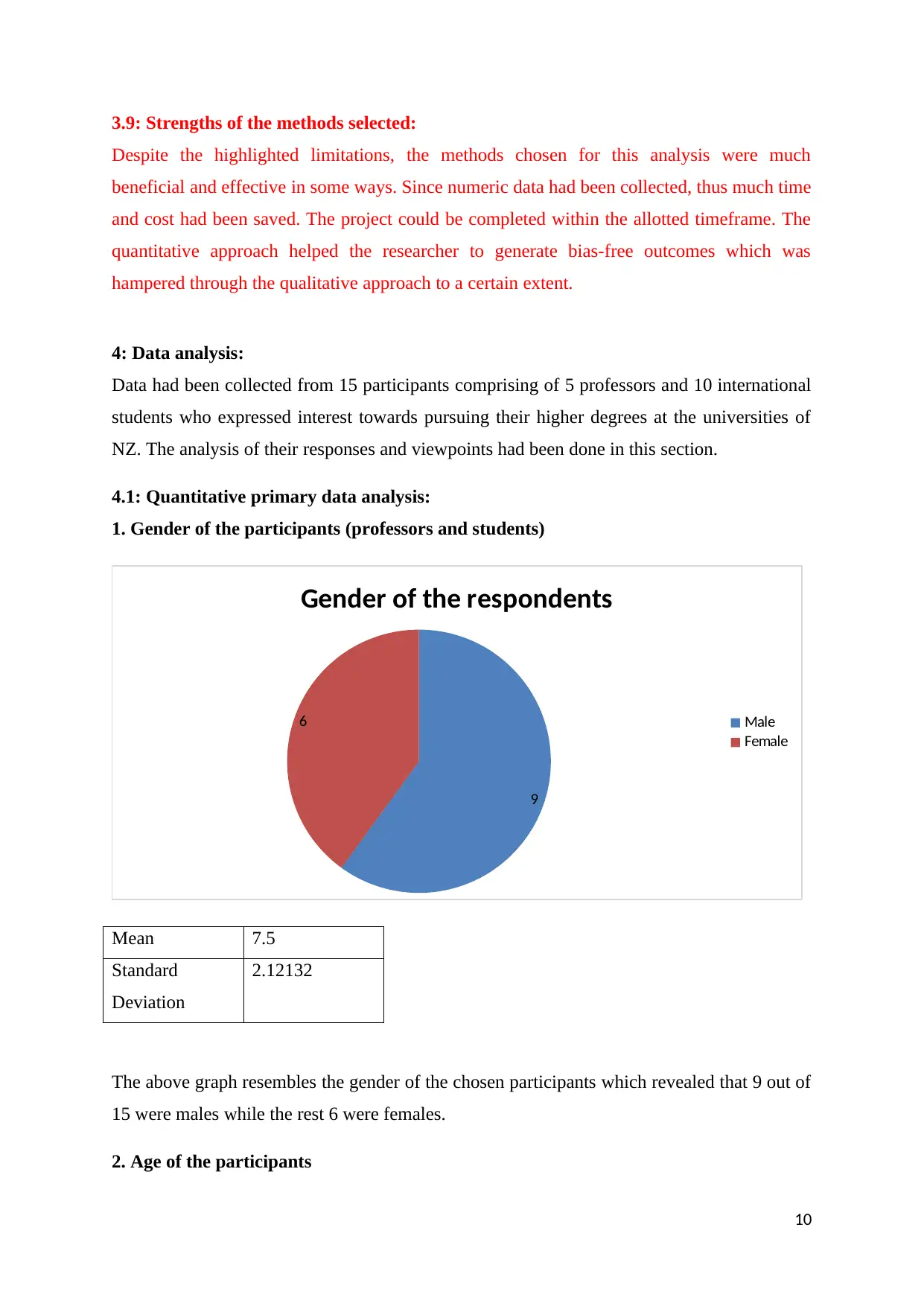
3.9: Strengths of the methods selected:
Despite the highlighted limitations, the methods chosen for this analysis were much
beneficial and effective in some ways. Since numeric data had been collected, thus much time
and cost had been saved. The project could be completed within the allotted timeframe. The
quantitative approach helped the researcher to generate bias-free outcomes which was
hampered through the qualitative approach to a certain extent.
4: Data analysis:
Data had been collected from 15 participants comprising of 5 professors and 10 international
students who expressed interest towards pursuing their higher degrees at the universities of
NZ. The analysis of their responses and viewpoints had been done in this section.
4.1: Quantitative primary data analysis:
1. Gender of the participants (professors and students)
9
6
Gender of the respondents
Male
Female
Mean 7.5
Standard
Deviation
2.12132
The above graph resembles the gender of the chosen participants which revealed that 9 out of
15 were males while the rest 6 were females.
2. Age of the participants
10
Despite the highlighted limitations, the methods chosen for this analysis were much
beneficial and effective in some ways. Since numeric data had been collected, thus much time
and cost had been saved. The project could be completed within the allotted timeframe. The
quantitative approach helped the researcher to generate bias-free outcomes which was
hampered through the qualitative approach to a certain extent.
4: Data analysis:
Data had been collected from 15 participants comprising of 5 professors and 10 international
students who expressed interest towards pursuing their higher degrees at the universities of
NZ. The analysis of their responses and viewpoints had been done in this section.
4.1: Quantitative primary data analysis:
1. Gender of the participants (professors and students)
9
6
Gender of the respondents
Male
Female
Mean 7.5
Standard
Deviation
2.12132
The above graph resembles the gender of the chosen participants which revealed that 9 out of
15 were males while the rest 6 were females.
2. Age of the participants
10
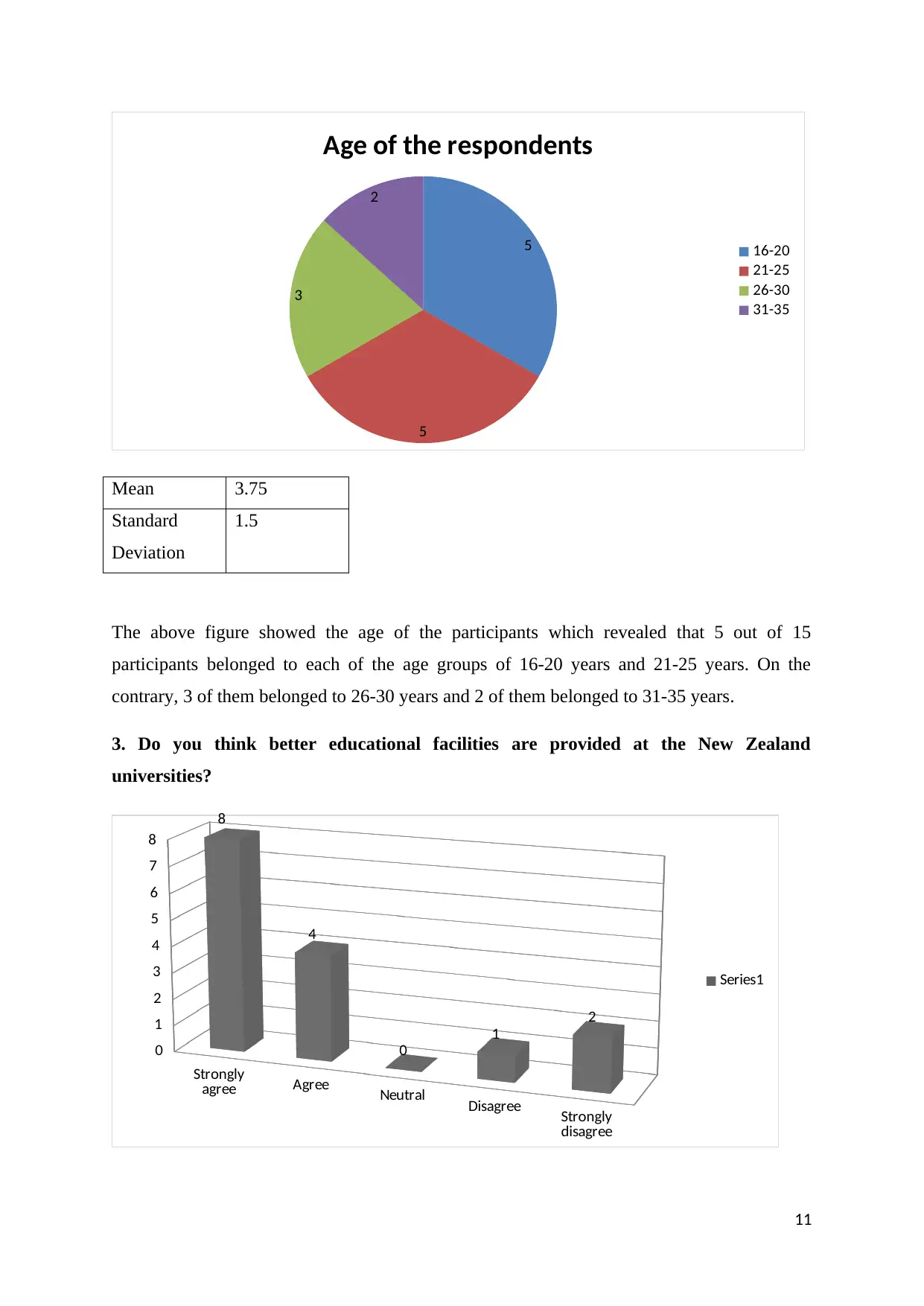
5
5
3
2
Age of the respondents
16-20
21-25
26-30
31-35
Mean 3.75
Standard
Deviation
1.5
The above figure showed the age of the participants which revealed that 5 out of 15
participants belonged to each of the age groups of 16-20 years and 21-25 years. On the
contrary, 3 of them belonged to 26-30 years and 2 of them belonged to 31-35 years.
3. Do you think better educational facilities are provided at the New Zealand
universities?
Strongly
agree Agree Neutral Disagree Strongly
disagree
0
1
2
3
4
5
6
7
8
8
4
0
1
2
Series1
11
5
3
2
Age of the respondents
16-20
21-25
26-30
31-35
Mean 3.75
Standard
Deviation
1.5
The above figure showed the age of the participants which revealed that 5 out of 15
participants belonged to each of the age groups of 16-20 years and 21-25 years. On the
contrary, 3 of them belonged to 26-30 years and 2 of them belonged to 31-35 years.
3. Do you think better educational facilities are provided at the New Zealand
universities?
Strongly
agree Agree Neutral Disagree Strongly
disagree
0
1
2
3
4
5
6
7
8
8
4
0
1
2
Series1
11
⊘ This is a preview!⊘
Do you want full access?
Subscribe today to unlock all pages.

Trusted by 1+ million students worldwide
1 out of 23
Related Documents
Your All-in-One AI-Powered Toolkit for Academic Success.
+13062052269
info@desklib.com
Available 24*7 on WhatsApp / Email
![[object Object]](/_next/static/media/star-bottom.7253800d.svg)
Unlock your academic potential
Copyright © 2020–2025 A2Z Services. All Rights Reserved. Developed and managed by ZUCOL.




